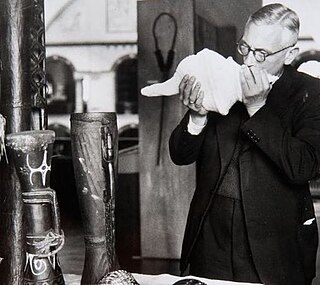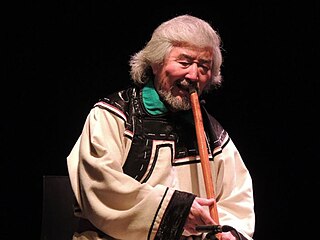Related Research Articles

A fiddle is a bowed string musical instrument, most often a violin. It is a colloquial term for the violin, used by players in all genres, including classical music. Although in many cases violins and fiddles are essentially synonymous, the style of the music played may determine specific construction differences between fiddles and classical violins. For example, fiddles may optionally be set up with a bridge with a flatter arch to reduce the range of bow-arm motion needed for techniques such as the double shuffle, a form of bariolage involving rapid alternation between pairs of adjacent strings. To produce a "brighter" tone than the deep tones of gut or synthetic core strings, fiddlers often use steel strings. The fiddle is part of many traditional (folk) styles, which are typically aural traditions—taught "by ear" rather than via written music.

Ethnomusicology is the multidisciplinary study of music in its cultural context, investigating social, cognitive, biological, comparative, and other dimensions involved other than sound. Ethnomusicologists study music as a reflection of culture and investigate the act of musicking through various immersive, observational, and analytical approaches drawn from other disciplines such as anthropology to understand a culture’s music. This discipline emerged from comparative musicology, initially focusing on non-Western music, but later expanded to embrace the study of any and all different kinds of music of the world.

Music is an integral part of Mongolian culture. Among the unique contributions of Mongolia to the world's musical culture are the long songs, overtone singing and morin khuur, the horse-headed fiddle. The music of Mongolia is also rich with varieties related to the various ethnic groups of the country: Oirats, Hotogoid, Tuvans, Darhad, Buryats, Tsaatan, Dariganga, Uzemchins, Barga, Kazakhs and Khalha.

The morin khuur, also known as the horsehead fiddle, is a traditional Mongolian bowed stringed instrument. It is one of the most important musical instruments of the Mongol people, and is considered a symbol of the nation of Mongolia. The morin khuur is one of the Masterpieces of the Oral and Intangible Heritage of Humanity identified by UNESCO.
Bruno Nettl was an ethnomusicologist who was central in defining ethnomusicology as a discipline. His research focused on folk and traditional music, specifically Native American music, the music of Iran and numerous topics surrounding ethnomusicology as a discipline.

Huun-Huur-Tu are a music group from Tuva, a Russian federative republic situated on the Mongolia–Russia border. Their music includes throat singing, in which the singers sing both a note and its overtones, thus producing two or three notes simultaneously. The overtone may sound like a flute, whistle or bird, but is solely a product of the human voice.
Mr Fox were an early 1970s British folk rock band. They were seen as in the 'second generation' of British folk rock performers and for a time were compared with Steeleye Span and Sandy Denny's Fotheringay. Unlike Steeleye Span they mainly wrote their own material in a traditional style and developed a distinct 'northern' variant of the genre. They demonstrate the impact and diversity of the British folk rock movement and the members went on to pursue significant careers within the folk rock and traditional music genres after they disbanded in 1972 having recorded two highly regarded albums.

Jean Jenkins was an American-born ethnomusicologist who spent most of her career based in the UK and travelled all over the world to collect sound recordings, slides and musical instruments.
The long song is one of the central elements of the traditional music of Mongolia. This genre is called "Long song" not only because the songs are long, but also because each syllable of text is extended for a long duration. A four-minute song may only consist of ten words. Certain long songs such as Uvgin shuvuu khoyor, also known as Jargaltain delger take up to three hours to sing at full length, with all thirty-two stanzas. Lyrical themes vary depending on context; they can be philosophical, religious, romantic, or celebratory, and often use horses as a symbol or theme repeated throughout the song. Eastern Mongols typically use a Morin khuur as accompaniment, sometimes with a type of indigenous flute, called limbe. Oirat groups of the Western Mongols traditionally sing long songs unaccompanied or accompanied with the Igil.

Mongol-Tuvan throat singing, the main technique of which is known as khoomei, is a style of singing practiced by people in Tuva and Mongolia. It is noted for including overtone singing. In 2009, it was included in the Representative List of the Intangible Cultural Heritage of Humanity of UNESCO. The term hömey / kömey means throat and larynx in different Turkic languages. That could be borrowed from Mongolian khooloi, which means throat as well, driven from Proto-Mongolian word *koɣul-aj.
Timbral listening is the process of actively listening to the timbral characteristics of sound.
Mark Slobin is an American scholar and ethnomusicologist who has written extensively on the subject of East European Jewish music and klezmer music, as well as the music of Afghanistan, where he conducted research beginning in 1967. He is Winslow-Kaplan Professor of Music Emeritus at Wesleyan University, where he taught both music and American Studies from 1971 to 2016.
Altan Urag is a Mongolian folk rock band. Formed in 2002, the band's musical style combines traditional Mongolian and contemporary influences. They're considered to be the pioneers of mongolian folk-rock.

Erynn Marshall is a Canadian old-time fiddler, ethnomusicologist, teacher, and author.
Erdenechimeg Luvsannorov is an ethnomusicologist and researcher.
Eduard Yefimovich Alekseyev was an ethnomusicologist who had conducted extensive field research on traditional music in Siberia and other regions of the former Soviet Union. His research focuses on theoretical problems of mode and melodic intonation, timbre, and notations as well as on sociological and psychological aspects of musical perception. He has served as a chairman of the Folklore Commission of the Union of Soviet Composers from 1972 to 1992. He has also served as a director of the department of the General Theory of Folklore at the Moscow State Institute of Art Studies.

Canadian fiddle is the aggregate body of tunes, styles and musicians engaging the traditional folk music of Canada on the fiddle. It is an integral extension of the Anglo-Celtic and Québécois French folk music tradition but has distinct features found only in the Western hemisphere.

The term African fiddle may be applied to any of several African bowed string instruments.

The tsuur, choor (Kyrgyz), or chuur is an end-blown flute of varying lengths that is common among Inner Asian pastoralists.
Ethnomusicology is the study of music from the cultural and social aspects of the people who make it. It encompasses distinct theoretical and methodical approaches that emphasize cultural, social, material, cognitive, biological, and other dimensions or contexts of musical behavior, in addition to the sound component. While the traditional subject of musicology has been the history and literature of Western art music, ethnomusicology was developed as the study of all music as a human social and cultural phenomenon. Oskar Kolberg is regarded as one of the earliest European ethnomusicologists as he first began collecting Polish folk songs in 1839. Comparative musicology, the primary precursor to ethnomusicology, emerged in the late 19th century and early 20th century. The International Musical Society in Berlin in 1899 acted as one of the first centers for ethnomusicology. Comparative musicology and early ethnomusicology tended to focus on non-Western music, but in more recent years, the field has expanded to embrace the study of Western music from an ethnographic standpoint.
References
- ↑ Rob Young, Electric Eden: Unearthing Britain's Visionary Music (2010), pp. 421-4337.
- ↑ Donald Clarke, The Penguin Encyclopedia of Popular Music (1990), p. 133.
- ↑ Nick Talevski, Rock Obituaries - Knocking On Heaven's Door (2010), p. 43.
- ↑ "Carole Pegg & Radik Tülüsh – Goshawk - Folk Radio UK". folkradio.co.uk. 9 December 2014. Retrieved 11 May 2017.
- ↑ Denselow, Robin (7 August 2014). "Carole Pegg & Radik Tülüsh: Goshawk review – bravely experimental" . Retrieved 11 May 2017– via The Guardian.